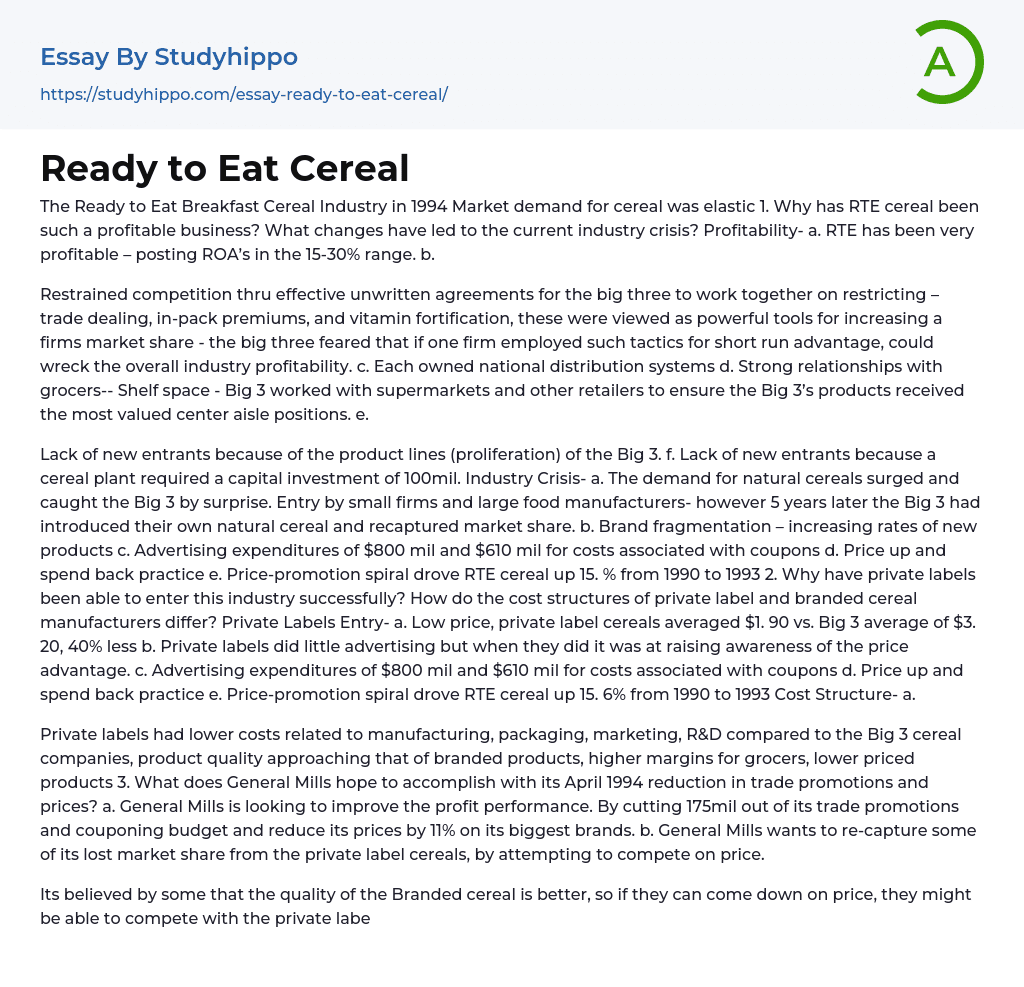The Ready to Eat Breakfast Cereal Industry in 1994 Market demand for cereal was elastic 1. Why has RTE cereal been such a profitable business? What changes have led to the current industry crisis? Profitability- a. RTE has been very profitable – posting ROA’s in the 15-30% range. b.
The big three used effective unwritten agreements to restrict competition and engage in trade dealing, in-pack premiums, and vitamin fortification. These tactics were seen as powerful tools for increasing market share, but the big three were concerned that if one firm used these tactics for short-term advantage, it could harm the overall profitability of the industry. Additionally, each of the big three had their own national distribution systems and strong relationships with grocers. They worked with supermarkets and other retailers to ensure that their products receiv
...ed the most sought-after center aisle positions. Furthermore, the lack of new entrants in the industry was due to the extensive product lines of the big three.
f. The lack of new entrants in the cereal industry was due to the high capital investment required for a cereal plant, which amounted to 100 million. The industry faced a crisis when there was a sudden surge in demand for natural cereals, catching the Big 3 companies by surprise. Although small firms and large food manufacturers entered the market during this time, after 5 years the Big 3 successfully introduced their own natural cereal and regained their market share.
b. The rate of new products is increasing, resulting in brand fragmentation.
c. Advertising costs of $800 million and $610 million are associated with coupons.
d. The practice of increasing prices and then reducing them again is bein
implemented.
e. The RTE cereal market experienced a 15% increase due to a price-promotion spiral.
Between 1990 and 1993, private labels were able to successfully enter the cereal industry. Their entry was characterized by low prices, with private label cereals averaging $1.90, in contrast to branded cereal manufacturers.
The average of the Big 3 is $3, which is 40% less than b. Private labels had minimal advertising, but when they did advertise, it was to increase awareness of their price advantage. The advertising costs were $800 million and $610 million for coupon-related expenses.
Price up and spend back practice e. Price-promotion spiral drove RTE cereal up 15.6% from 1990 to 1993 Cost Structure- a. Private labels had lower costs related to manufacturing, packaging, marketing, R&D compared to the Big 3 cereal companies, product quality approaching that of branded products, higher margins for grocers, lower priced products 3. What does General Mills hope to achieve with its April 1994 reduction in trade promotions and prices? a. General Mills aims to enhance profit performance.
General Mills aims to regain lost market share from private label cereals by implementing a strategy that involves cutting $175 million from its trade promotions and couponing budget while simultaneously reducing prices by 11% on its major brands. This move is driven by the belief that Branded cereal offers superior quality compared to private labels, and by lowering prices, General Mills hopes to effectively compete with these private label counterparts.
Typically, the Big 3 companies tend to follow each other. Therefore, General Mills' move could positively impact the profitability of the other two companies. However, there are risks associated with these actions. One risk is that it
could potentially drive down industry profitability due to lower prices. Additionally, it is also important to consider how General Mills' competitors will respond to these actions.
Going against the unwritten agreement of the Big 3 could potentially initiate a cereal war. In response, competitors such as Kellogg and Phillip Morris are expected to act similarly to General Mills. As for General Mills, they should reduce their reliance on couponing, find ways to reduce expenses, but still maintain their advertising efforts.
6. Is this industry appealing? - Yes a. The threat of new entrants has historically been high due to a high barrier of entry and the Big 3 having a monopoly. b. The bargaining power of customers is low. c. The threat of substitutes is low.
Bargaining power of suppliers is relatively high. Additionally, rivalry among existing competitors in the industry has historically involved working together with unwritten agreements in order to maintain profitability.
- Chief Executive Officer essays
- Convenience Store essays
- Firm essays
- Training And Development essays
- Unilever essays
- Variable Cost essays
- Virgin Group essays
- Bargaining essays
- Entity essays
- Pest analysis essays
- Advertising essays
- Audience Theory essays
- Competitor Analysis essays
- Consumer essays
- Marketing Management essays
- Marketing Mix essays
- Marketing Plan essays
- Marketing Research essays
- Marketing Strategy essays
- Point Of Sale essays
- Price essays
- Procurement essays
- Product essays
- Product Differentiation essays
- Promotion essays
- Promotion And Marketing Communications essays
- Retailing essays
- Trademark essays
- Anheuser-busch essays
- Brands essays
- Detergent essays
- Product Placement essays
- Research Design essays
- New Product Development essays
- Advertisement essays
- Brand essays
- Sales Promotion essays
- Advertising campaign essays
- Consumer behaviour essays
- Offer And Acceptance essays
- Wal-Mart essays
- Discover essays
- John Locke essays
- 9/11 essays
- A Good Teacher essays
- A Healthy Diet essays
- A Modest Proposal essays
- A&P essays
- Academic Achievement essays
- Achievement essays




